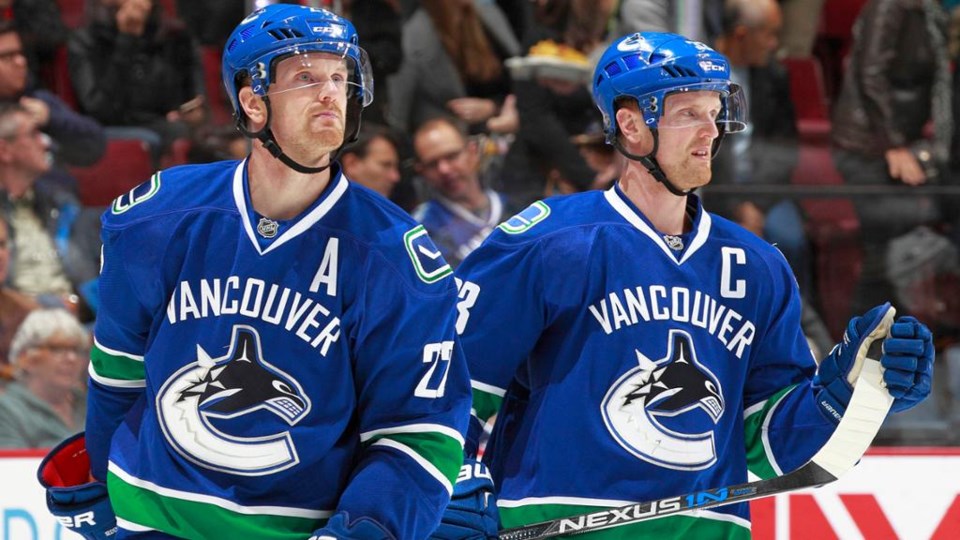Heading into the 2017-18 season, the Sedins attempted to deflect any questions about their future with the Canucks by publishing an article with The Players Tribune. In it, they got out ahead of two significant stories that could have dogged them throughout the season.
The first story: would they get traded if the Canucks were sellers at the trade deadline? The Sedins made it emphatically clear: “We won’t play anywhere else.”
“If we’re going to win a Cup,” they continued, “we only want it to be with Vancouver – that will never change. And if the moment has come and passed already, then so be it.”
That part of the article worked. There have been no real calls for the Canucks to trade the Sedins. It’s simply not a story.
They also tried to avoid any questions of whether they would re-sign with the Canucks. That didn’t work quite as well, as that story has re-emerged this week after a report from Chris Johnston on Hockey Night in Canada that the Sedins want to return for another season.
That report coming out now contradicts their stated intention in the Players’ Tribune article to wait until the off-season to make any decisions:
“We’re going to take this year to work hard and build something special with the young guys around us. And when it ends, we’ll see where we’re at and what we want to do.”
It became clear after the weekend, however, that it was the Canucks who approached the Sedins and their agent, J.P. Barry, trying to get an indication of where the Sedins were leaning.
“We’re not going to hold them to anything now," said Jim Benning, "but for planning purposes, what they might want to do could affect decisions we make at the deadline.
Benning went no further than that, but Iain MacIntyre speculated on what that might mean, suggesting that it could impact whether or not they trade Thomas Vanek, as well as the type of return they might seek in an Erik Gudbranson trade. Benning wants to know what the Sedins are planning, as it could change what he does at the trade deadline.
It really shouldn’t.
Let’s start with Vanek. It would be the height of foolishness to keep Vanek at the trade deadline; Vanek’s added value as a trade asset was one of the main reasons his signing at the end of the summer made sense.
Vanek has been as good or better than advertised, meshing well with Brock Boeser when Bo Horvat and Sven Baertschi were on the shelf with injuries. He’s been a boon to the power play as well: he’s tied for second on the team in power play points, while playing mainly on the second unit, away from Boeser.
His surprisingly strong season has no bearing on whether or not the Canucks should trade him. Neither does the question of whether or not the Sedins will re-sign with the Canucks.
Simply put, the Canucks need future assets. They need the prospect and/or pick that Vanek will get them in a trade more than they need Vanek himself, with all due respect to Vanek. The Canucks are not as far along in the rebuilding process as they expected or hoped they would be and they need to continue adding picks and prospects to the system.
Yes, if the Sedins choose to retire at the end of the season, the Canucks will immediately lose two top-six forwards and will have a hard time replacing them, but keeping Vanek at the deadline and re-signing him would be like trying to stay dry while the Titanic sinks by opening up an umbrella.
Vanek will be an unrestricted free agent at the end of the season; if the Canucks are so eager to bring him back next season, they can. Otherwise, there will be other options on free agency or the Canucks can choose to ride or die with their young players and prospects.
Then there’s Gudbranson, who is about as obvious a trade target as it gets. It’s unfortunate for Gudbranson, who was well-loved in Florida and would likely still be with the Panthers if Dale Tallon had an uninterrupted tenure as GM, but he hasn’t been a fit in Vancouver. The Canucks need to move him at the deadline if they want to recoup any of the assets they spent acquiring him, as he’s unlikely to be re-signed in the summer.
MacIntyre suggested that the Sedins’ decision would play into what type of assets the Canucks seek in return for Gudbranson, but that type of thinking is extremely worrying to me. The Canucks have needs in their prospect pool at pretty much every position and the Canucks should address one or more of those needs in the Gudbranson trade.
What they shouldn’t do is try to bring in an established NHL player in an attempt to fill the Sedins’ shoes. Any trade they make shouldn’t be about next season, but about helping to build the franchise for the next ten years. That means a prospect, at any position, with the potential to be an impact player, not just someone who can fill a roster spot.
I can understand Jim Benning wanting as much information as possible heading into the trade deadline, but this is an example of information that could cause confusion rather than make things more clear. Let the question of whether the Sedins will return for another season wait for another few months.



